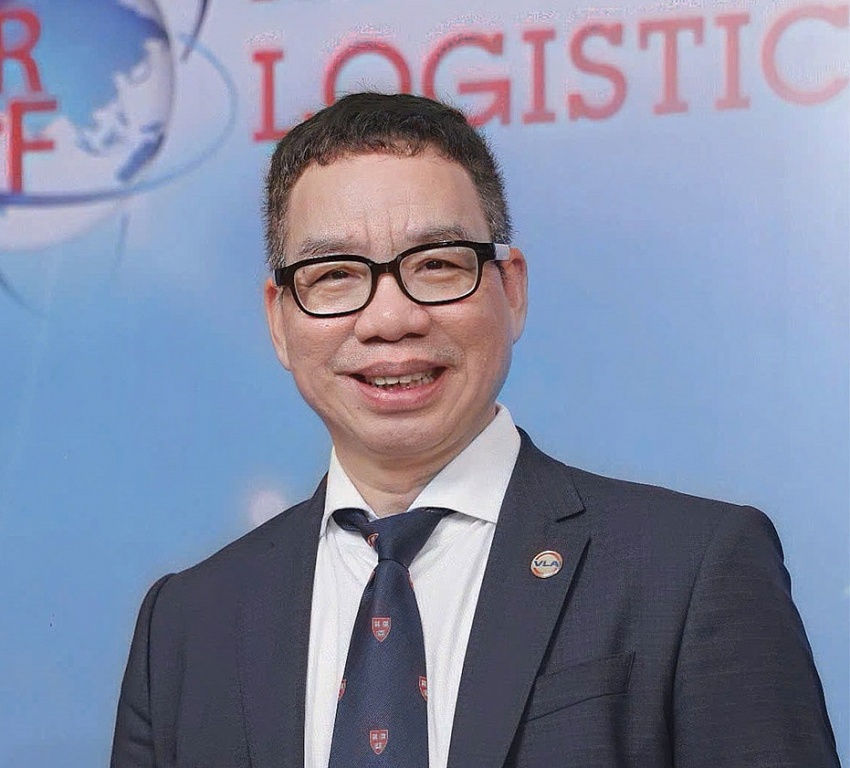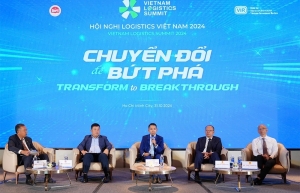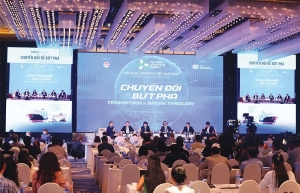2025 - A breakthrough year for Vietnam’s logistics industry
What was the main investment trend and competition in the logistics market in 2024?
 |
| Dao Trong Khoa, president of the Vietnam Logistics Business Association |
The logistics market in 2024 was increasingly competitive due to the strong participation of both domestic and international enterprises. Domestic enterprises face pressure from large corporations with strong financial and technological potential. However, this is also a driving force for domestic firms to improve service quality and develop innovative solutions. There are several investment and business trends in the market during the period. The first is technology adoption. Businesses are tending to make investments in digital platforms, integrated supply chain management systems, and automation technology.
The second aspect is green logistics: developing sustainable green transportation, warehousing, and seaport services, in line with global trends towards environmental protection. There is also developing domestic supply chains for the manufacturing and export industries; and investing in logistics centres. Businesses are investing in building large-scale logistics centres, strategically located in industrial parks and import-export gateways, to tap into their potential.
Another factor is developing logistics for e-commerce. It is expected that automated sorting centres, as well as last-mile delivery, will grow strongly in the coming years as the size of the Vietnamese e-commerce market is forecast to continue to grow by over 20 per cent.
How did Vietnam’s logistics industry integrate into the global supply chain last year?
The year 2024 marked an important milestone in the remarkable development of Vietnam’s logistics industry. Large-scale projects were approved and implemented, prestigious international events were organised, and breakthrough reforms in infrastructure and policies have created a solid foundation for the industry’s growth.
In digital transformation, more logistics businesses are adopting advanced technology, from warehouse management systems and transportation management systems to AI and blockchain, to help optimise operations and increase supply chain transparency.
Furthermore, many member businesses of ours have invested in environmentally friendly means of transport and route optimisation solutions, are using renewable energy, developing green ports, carbon accounting, afforestation, forest enrichment, and participating in the carbon credit market.
2024 also saw outstanding development of the seaport system. Seaports were invested in, especially in the Haiphong, Ho Chi Minh City, and Ba Ria-Vung Tau. In recent years, the Cai Mep port cluster has been named one of the most efficient container ports worldwide.
The industry promoted international links and logistics diplomacy. The signing and implementation of free trade agreements continue to open up opportunities for logistics businesses to expand their markets. In addition, logistics diplomacy was also promoted with delegations participating in freight forwarding, transportation, and logistics events in the region as well as globally.
In particular, there has been careful preparation for the FIATA World Congress 2025, which will be held in Hanoi in October. This is a great opportunity for Vietnam to affirm its role as an important link in the global supply chain while attracting the attention of the international logistics community.
However, there are still many challenges facing the industry. Vietnam’s logistics costs remain high, despite significant improvements. We estimate that the ratio of logistics costs to Vietnam’s GDP in 2025 will remain at 15-16 per cent. This figure is equivalent to the average of the Asia-Pacific region but still higher than the global average, thus reducing the competitiveness of Vietnamese goods.
In addition to that, the scale of Vietnam’s logistics industry compared to the scale of the national economy and the global logistics market is still modest, posing many challenges for development and international integration.
Infrastructure is not synchronised. The connection among modes of transport (road, sea, and rail) is still limited, causing pressure on the supply chain. Logistics infrastructure is being invested in, but there is still a gap compared to the region and the rest of the world.
The quality of personnel in logistics has also not met development needs, especially in the context of strong digital transformation.
What are the investment and business development prospects in the local logistics market in 2025?
This year is expected to be a breakthrough year for Vietnam’s logistics industry thanks to favourable factors. The first is the growth of e-commerce. The need for fast, accurate shipping will continue to drive logistics.
Secondly, infrastructure investment is being boosted. Major projects such as deepwater ports, the North-South expressway, and modern logistics centres will come into operation.
The third is deep international integration, and trade deals will continue to create great opportunities for logistics.
The development prospects in 2025 are very positive, especially when Vietnam hosts the FIATA World Congress 2025. This is a unique opportunity to enhance the national image, connect with international partners, and create new momentum for the development.
Along with the increase in e-commerce and the completion of major infrastructure projects, that event will be a platform for Vietnamese logistics to ensure long-term strategies, from reducing logistics costs and developing green logistics to enhancing global competitiveness.
However, the industry also needs to make preparations for challenges such as market fluctuations, higher requirements for green logistics, and competition from other nations. With the right development and strong support from the government, more opportunities will open with fruitful outcomes awaiting the industry.
 | Coordination can ease logistics issues It is time for logistics companies to embrace green transition, digital transformation, and business model restructuring. Dao Trong Khoa, chairman of the Vietnam Logistics Business Association, shared with VIR’s Bao Giang about the emerging directions for logistics companies. |
 | Costs and competition head logistics advancement issues Accelerating transport infrastructure connections and investing in the development of logistics centres is the key to helping reduce logistics costs and increasing competitiveness for businesses. |
 | Green is new buzzword for logistics arena As sustainable development becomes a mandate to operate in the logistics industry, companies are stepping up their efforts to green their operations. |
What the stars mean:
★ Poor ★ ★ Promising ★★★ Good ★★★★ Very good ★★★★★ Exceptional
Related Contents
Latest News
More News
- How AWS is powering the next-gen data era (December 09, 2025 | 13:14)
- Outlook in M&A solid for Singapore (December 08, 2025 | 10:31)
- Vietnamese firms are resetting their strategy for global markets (December 05, 2025 | 17:04)
- LPBank Securities accelerates AI and data innovation with AWS (December 05, 2025 | 09:00)
- Improving traceability capacity with Zebra Technologies (November 26, 2025 | 10:08)
- Ho Chi Minh City engages 500 CEOs in dialogue on building global megacity (November 25, 2025 | 16:00)
- CEO shares insights on Phu My 3 IP’s journey to green industrial growth (November 17, 2025 | 11:53)
- NS BlueScope CEO highlights decade of sustainable steel efforts (November 15, 2025 | 10:00)
- SCG maintains strong cash flow and drives low-carbon growth in Q3 (November 07, 2025 | 09:53)
- Thai Huong: a visionary business leader bridging Vietnam and Russia (November 05, 2025 | 17:00)

 Tag:
Tag:






















 Mobile Version
Mobile Version